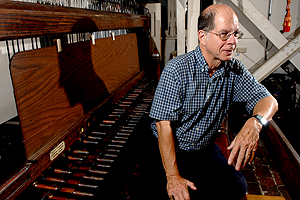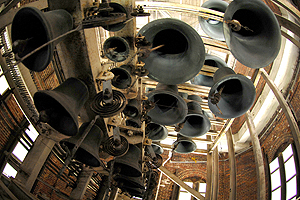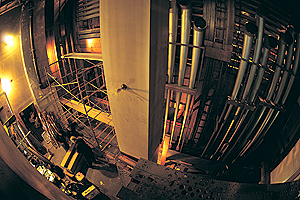Three-year odyssey of historic instruments to culminate with June 7 concert in Rockefeller Memorial Chapel
By Josh Schonwaldjschonwa@uchicago.edu
News Office
 Photos by Dan Dry University Carillonneur Wylie Crawford will resume playing the Laura Spelman Rockefeller Memorial Carillon, now that the instrument has been restored and enhanced by experts from the Netherlands. |
|
Two of the most historic and storied instruments in North America are, at last, back and better than ever.
It was an odyssey, taking three years, more than $3 million and the combined efforts of specialists from the Netherlands and Orrville, Ohio, but finally the University’s Rockefeller Memorial Chapel will present a concert featuring the sounds of both the world’s second-largest carillon and Chicago’s largest organ.
The public will have a chance to hear the Laura Spelman Rockefeller Memorial Carillon and the Ernest M. Skinner pipe organ in a free gala at 4:30 p.m. Saturday, June 7. No reservations are required.
In addition to the restoration, which has greatly enhanced the sound of both the organ and carillon, the chapel has commissioned works by William Bolcom and Marta Ptaszynska, the Helen B. and Frank L. Sulzberger Professor in Music and the College. Performing the commissioned works will be Tom Weisflog, University Organist, and the combined voices of the Rockefeller Memorial Chapel Choir, the Motet Choir, the University Singers and the University Chorus, under the direction of James Kallembach, Director of Choral Activities in Music and Director of the Rockefeller Memorial Chapel Choir.
The carillon program, which will be heard on the chapel lawn, will feature masterworks performed by Wylie Crawford, University Carillonneur; James Fackenthal, Assistant University Carillonneur; and Milford Myhre, a world-renowned carillonneur.
“It’s truly going to be a mecca for great organ music,” said Tom Weisflog, who has been the University Organist since 2000. A veteran organist who has played some of the world’s great organs during his lifetime, including Coventry Cathedral and the Mormon Tabernacle, Weisflog said the restoration of the Earnest M. Skinner organ is already creating a buzz throughout the world of organists. The leading organ magazines are planning to feature it on their covers, and some of the world’s great organists are planning to come to Chicago to play the massive instrument.
Restored at a cost of $2.1 million, the organ now has 8,565 pipes and more than 132 ranks (sets), making it the largest instrument in Chicago. “The sound will be earth-shattering,” said Weisflog. “The building will literally shake.”
 The restoration of the Laura Spelman Rockefeller Memorial Carillon (above) and the Ernest M. Skinner pipe organ (below) have been completed, and both instruments are scheduled to debut in their new renovated states in a Saturday, June 7 gala concert at Rockefeller Memorial Chapel. Both the carillon and organ have been enhanced to create sounds that will be new to their audiences. |
|
 |
Built in the 1920s by master American organ-maker Ernest M. Skinner, for the then-staggering cost of $76,500, the massive organ—with pipes soaring as high as four stories—was originally the model of the perfect Romantic sound. It was one of Skinner’s four University organs; the others are Yale, Michigan and Princeton. When it debuted in 1928, the Skinner Opus 634 boasted 6,980 organ pipes distributed over 108 ranks, ranging in speaking length from 3/8 inch to 32 feet.
But time took its toll. Constant use and accumulated grime damaged the instrument. In the 1970s, many of the original pipes were replaced with Baroque counterparts. Then, a chapel restoration in the 1980s successfully preserved and hardened the ceiling, but left the organ further dilapidated. “There was water damage from a leaky roof and windows,” said Weisflog. “Organs don’t like water.” The result was an organ with hundreds of dead notes, pipes sticking in the open position and many loud air leaks. In January 2001, only a year after Weisflog’s arrival, a rented electronic organ was finally brought in, and the Skinner organ was retired.
During the quiet years, most of the missing original pipes were relocated and repurchased.
In 2005, President Emeritus and ethnomusicologist Don Randel declared during a sermon at the chapel, the restoration of both the carillon and the organ a priority. He said he would not leave the University until the funds to do so were in hand. Later that year, trustees and friends of the University presented Randel with a small token birthday gift of $1.6 million, with promises of continued effort toward the instruments’ restorations.
In July 2006, a team from the Schantz Organ Company, which is renowned for its restoration work on Skinner organs, spent two weeks dismantling, sorting and labeling 7,000 pipes. The organ was shipped to Schantz’s factory in Ohio for the painstaking and time-consuming restoration process.
Now, newly rebuilt and enlarged, the original Romantic character of the organ has been restored, and an additional 24 ranks have been chosen in the style of the other three university organs.
Another major change, Weisflog said, was architectural. A new tonal arch in the south wall of the chancel organ chamber has been created in order to allow propagation of sound directly into the main nave of the chapel.
“Originally, the sound came out of the side through the organ façade, on the east wall of the chancel, then it came out, and bounced around repeatedly,” said Weisflog. “This change will greatly enhance the volume. It’s unbelievably present.”
The other major addition to the Skinner is what Weisflog calls the instrument’s “tonal crown.” It’s formally known as the Randel State Trumpet, in honor of the former president. “It’s really one of the most thunderous sounds of any organ anywhere,” said Weisflog, as he demonstrated.
The University’s Organist isn’t the only Chapel musician in a state of near-ecstasy.
Wylie Crawford, the University Carillonneur, is on the verge of playing the second-largest carillon in the world after nearly a one-year hiatus. But when he enters the bell tower this June, the carillon he will be playing will be quite different.
First, people will be able to hear the carillon in its intended dynamism. In the past, much of the historic instrument was hard to hear. “But now, you’ll be able to hear the middle and upper octaves,” said Crawford.
The instrument also will allow the carillonneur to play a faster, more nuanced piece. “It’ll allow a more dynamic range.” Anyone who has heard Crawford play Géo Clément’s Campanella will clearly hear the difference, he explains, between “the fortissimo and the pianissimo.”
 Thomas Weisflog, University Organist, watched as the Ernest M. Skinner pipe organ was dismantled in July 2006. Like Crawford, he too, will take his seat at the instrument he has been eager to play in its new restored state. |
What’s more, much like the buzz the Skinner organ’s renovation is causing, the carillon’s restoration is capturing the attention of carillonneurs. Prior to its restoration, said Crawford, “Some of the carillonneurs wouldn’t play it. Now, with its full range restored, they’re very eager.”
The newly empowered instrument is the result of a massive and much-needed renovation for an instrument that was built in 1932 in remembrance of Laura Spelman Rockefeller, John D. Rockefeller Jr.’s mother. Housed in the chapel tower, it has 72 bells, ranging from 10.5 pounds to 18.5 tons. The great bourdon, or bass bell, boasts a diameter of nearly 10 feet. Though carillons are built to last for centuries, the playing mechanism in the carillon had deteriorated over the years. “It became especially noticeable in the third octave,” said Crawford.
Beginning last September, the carillon’s 58 upper bells—more than half of the instrument—were dismantled. Forty-six of the smaller bells were sent on a seven-month journey to the Netherlands, where experts at the Royal Eijsbouts foundry, one of only a handful of firms in the world that specializes in the restoration field, reconditioned them. The remaining 12 bells were stored in Chicago during the restoration.
New iron clappers, which strike the bells to create sound, were replaced for the instrument’s 58 smallest bells. A new console was added and new linkages were made between the console and the bells. “This will make it a much more responsive instrument,” said Crawford.
Two other crucial design changes were made. One remedies a mistake made during the installation. Though carillon playing has been around for nearly 500 years, this carillon, said Crawford, was among the first installed in North America. The New World carillonneurs made a mistake; they used clappers that became smaller as the bells became smaller over time. This was, unfortunately, the wrong approach. “In order to make the smaller bells heard,” said Crawford, “you needed to have proportionally larger clappers.”
Another design change was the reorganization of the smaller bells above the cabin, which will make them more audible to the audience. Before the renovation, the smallest bells were directly over the cabin. “This was good for the performer, but not for the audience,” said Crawford. “The sounds from the smaller bells couldn’t be heard.”
These bells have been reinstalled using a reconfigured, galvanized structural steel frame. All of the upper 58 bells were remounted on the new upper bell frame. Below the cabin, obsolete workings were updated, and the steel frame will be painted.
Also, following the gala, Facilities Services will install a new playing cabin that will be slightly larger to accommodate larger tour groups. The addition of heat and air conditioning will make the trek up the spiral stairs a more rewarding and comfortable experience for both carillonneurs and guests.
The complete renovation of the carillon will be featured in a video documentary online this summer.
![[Chronicle]](/images/sidebar_header_oct06.gif)